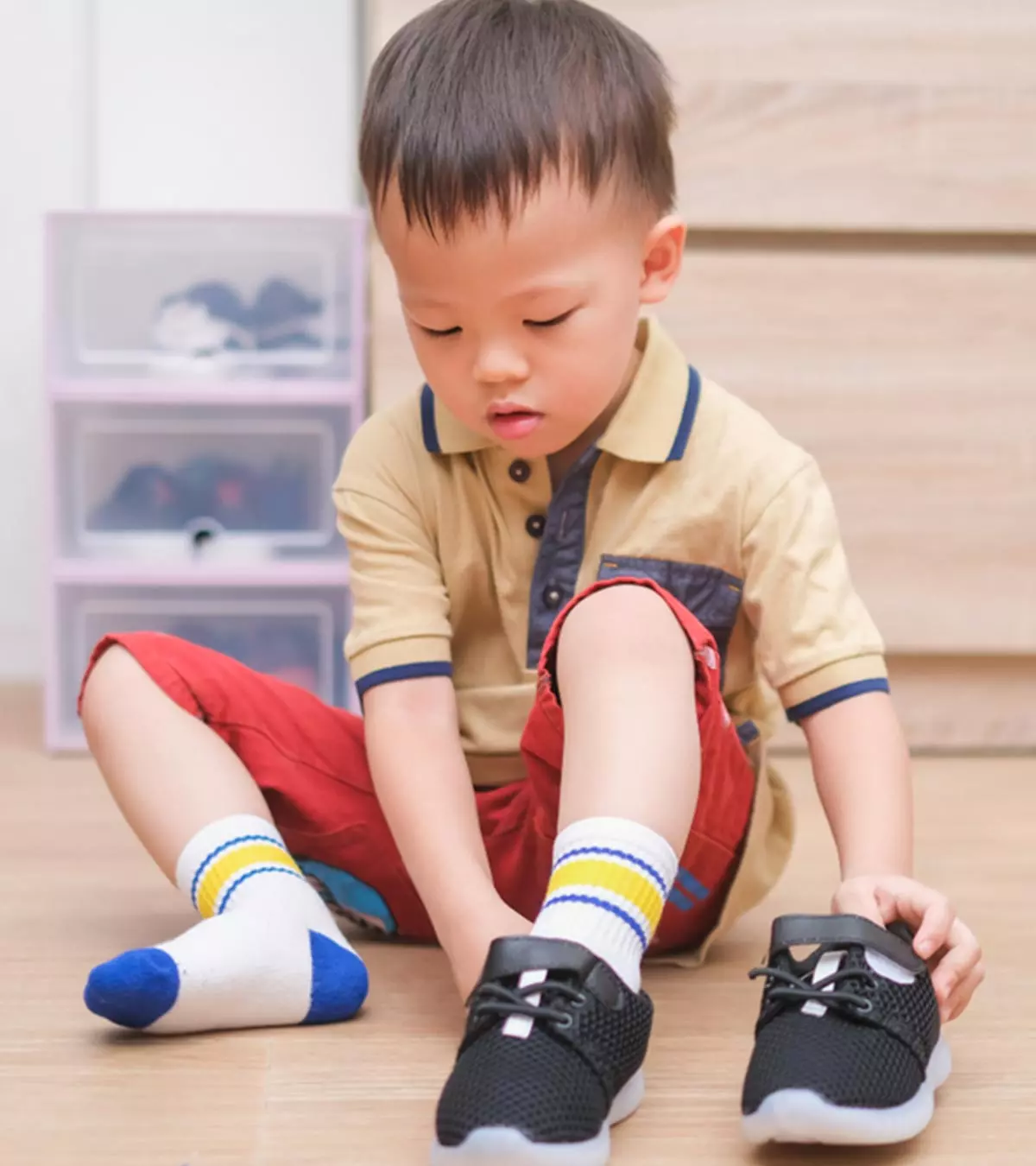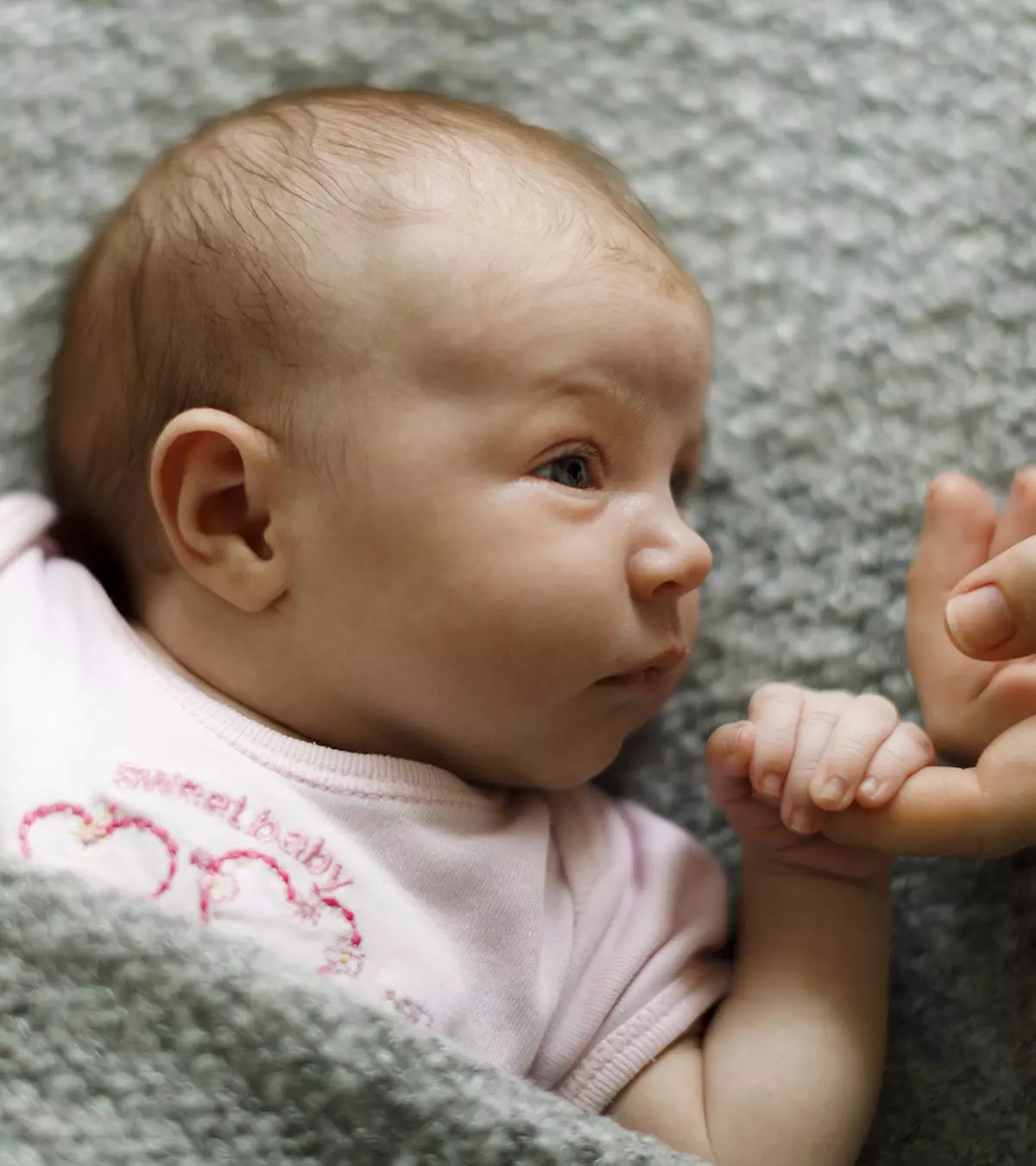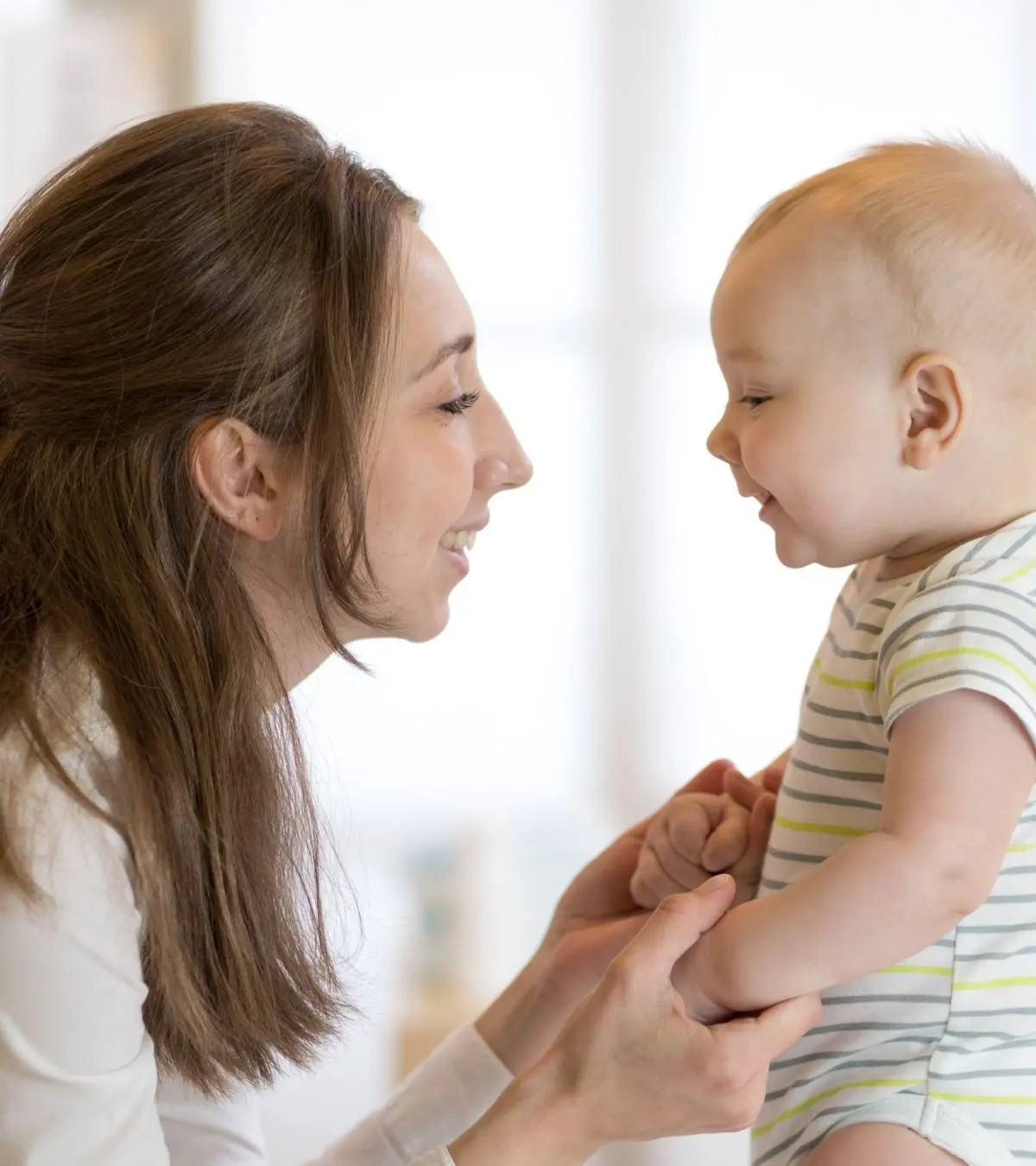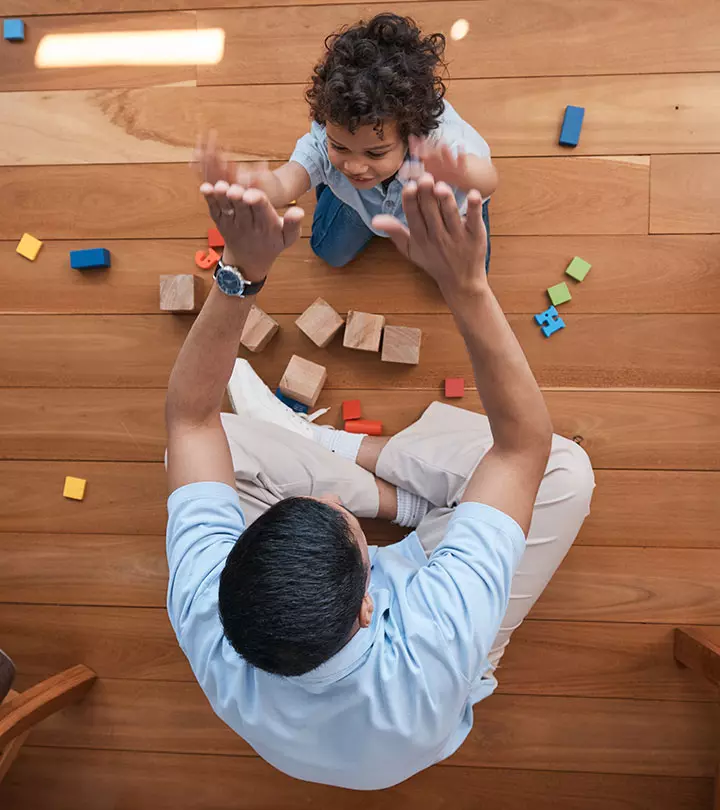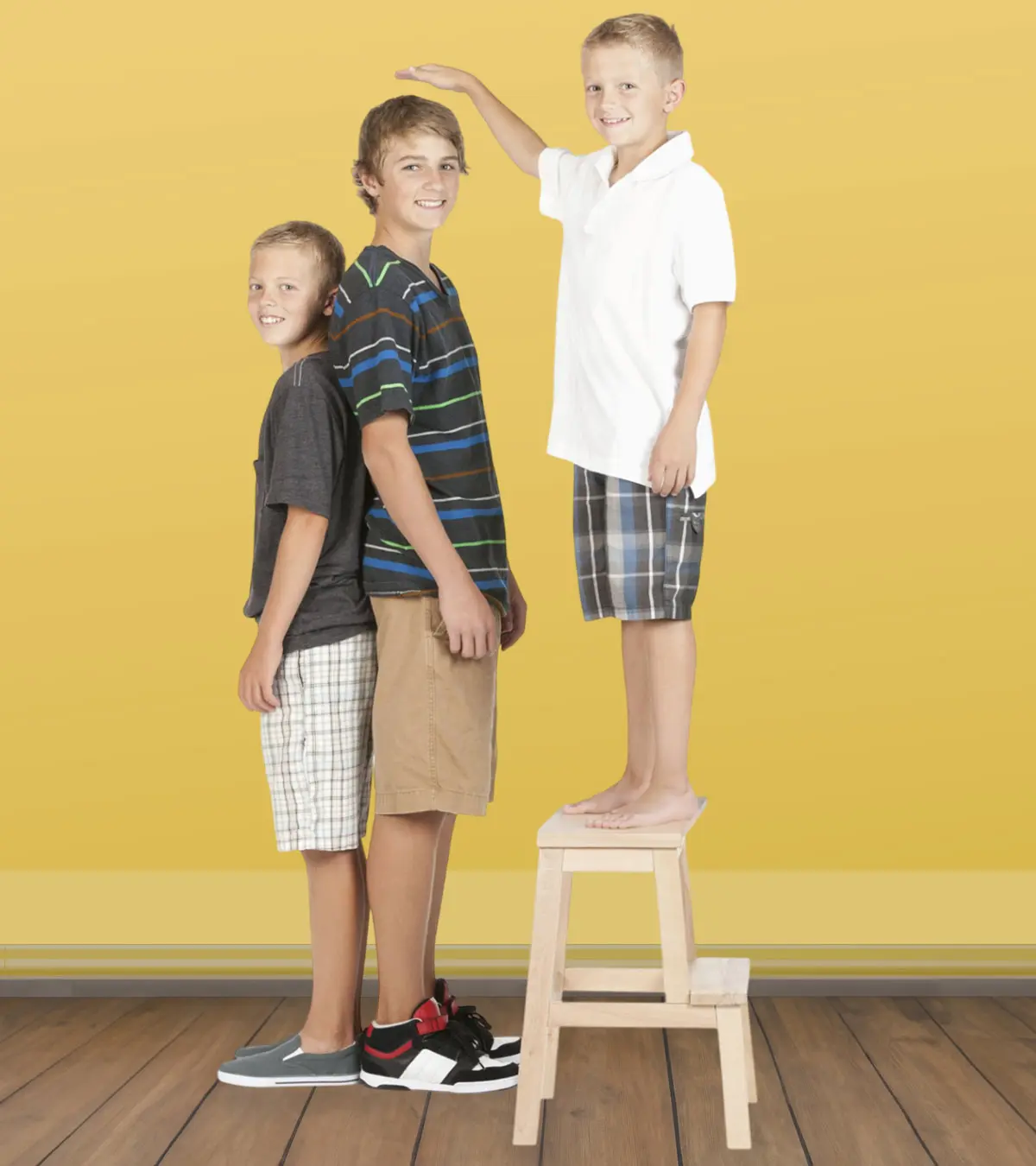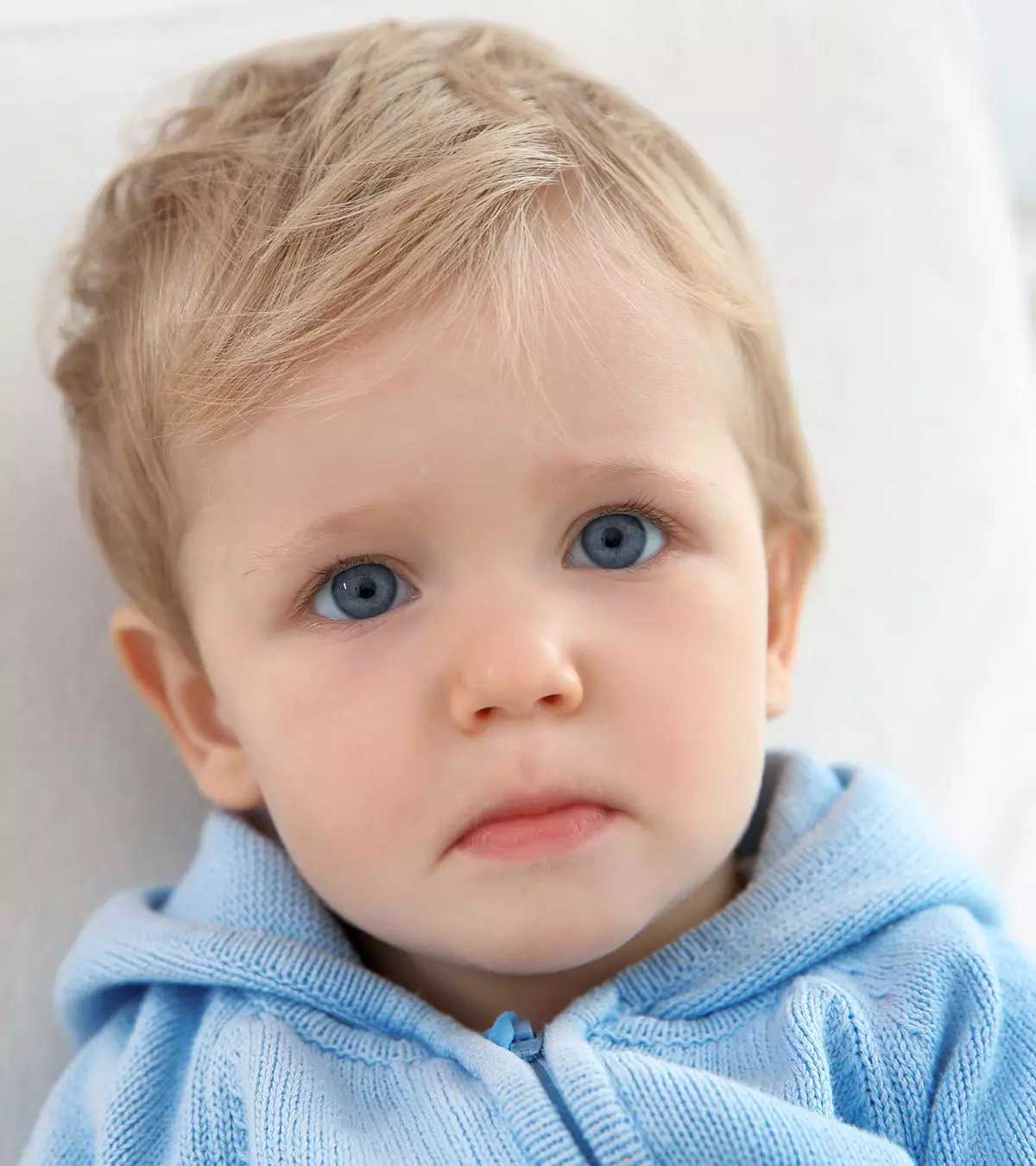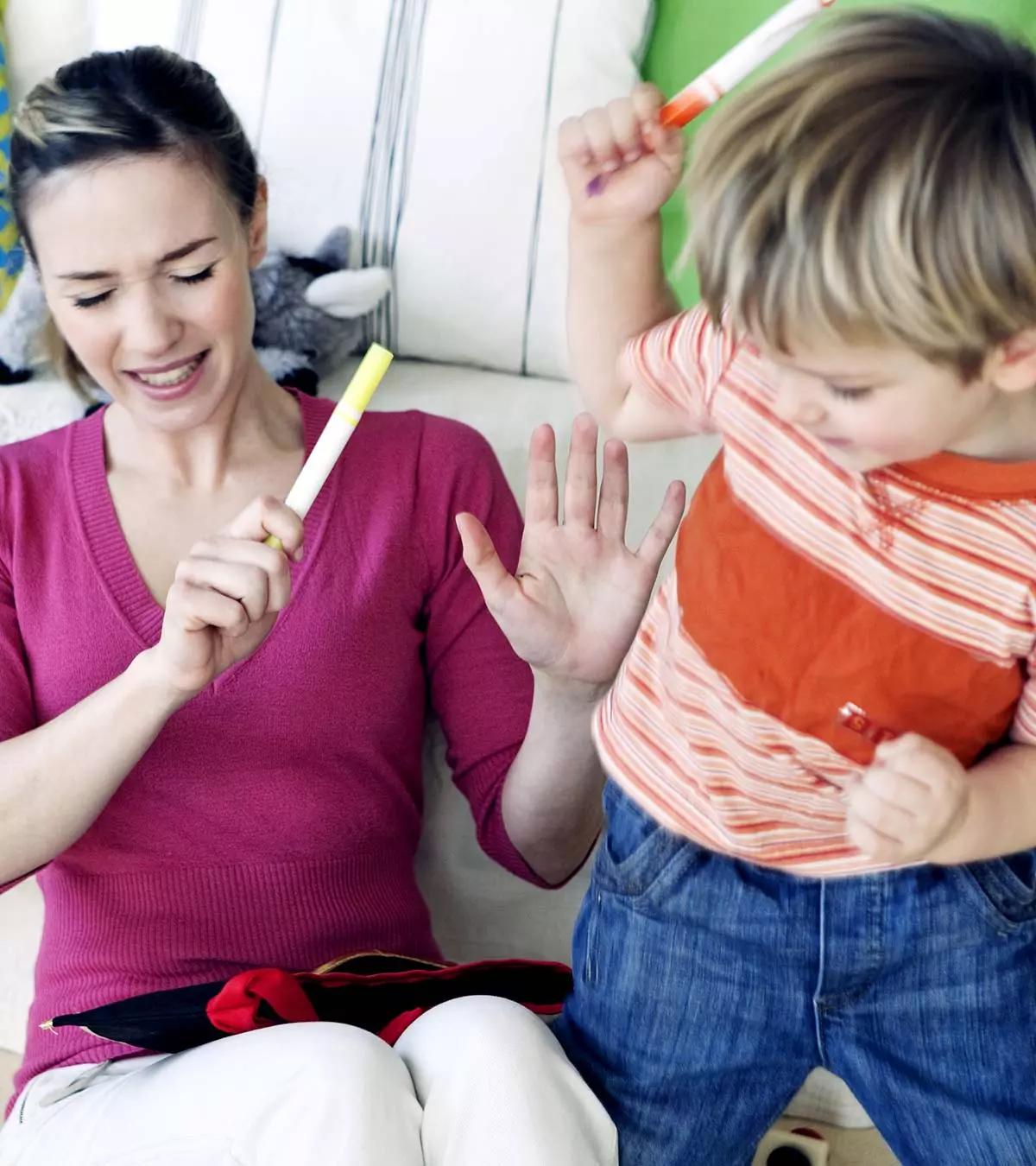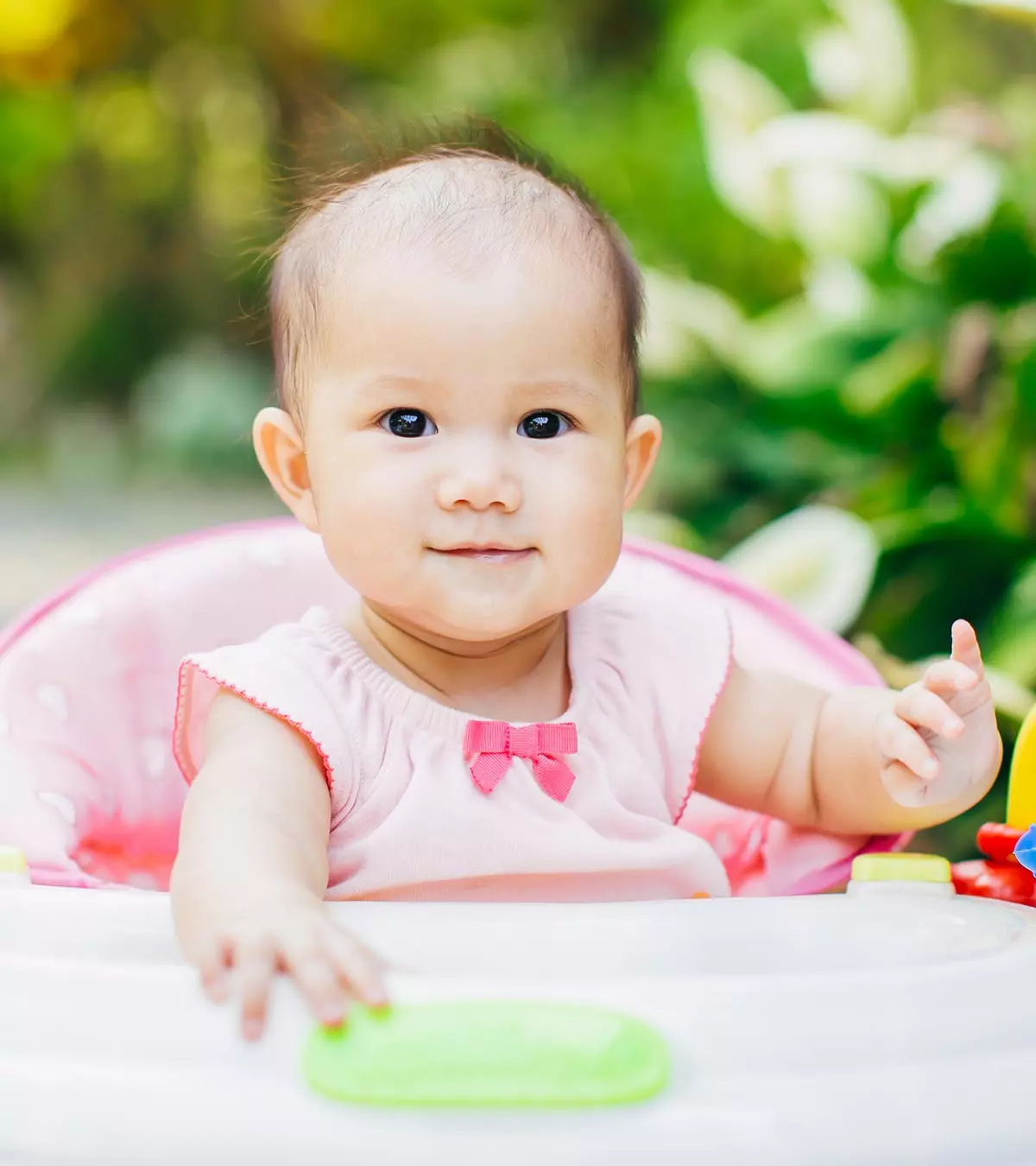
Image: ShutterStock
It’s been three months since your baby was born, and it may seem like time has passed by in the blink of an eye. However, by this time, they may have reached many developmental milestones. Hence, their 3-month-old baby developmental milestones should be monitored to track their growth trajectory and well-being. They will become more active and curious about the world around them, showing a keen interest in exploration. Bonding with your little one is also important at this stage, as they start recognizing familiar faces and voices, and responding to them. Your baby’s reflexes will also be improving, as they start to grasp objects and respond to touch more quickly.

Key Pointers
- The cognitive, physical, social, and emotional development of three-month-old babies is rapid.
- Cognitive achievements at this age include copying some sounds and activities, locating sounds, responding to interactions, and recognizing familiar faces.
- Physical milestones include maintaining head stability, elevating the head while on the stomach, tracking objects with their eyes, bringing their hand to their mouth, and grabbing items.
- Social and emotional milestones of three-month-old babies include laughing and smiling, being reserved among strangers, and playing with simple toys.
Three-Month-Old Baby Milestones Chart
| Achieved developmental milestones | Emerging developmental milestones |
|---|---|
| Lifts head by 45º during tummy time | Can move head to 90º |
| Pushes leg down when held vertical | Will bear weight on feet when held vertical |
| Brings hands to mouth | Can bring hands together |
| Grasps objects within reach | Attempts grabbing objects beyond reach |
| Shakes object in hand | Will hit the object to a surface and play |
| Tracks moving objects within the field of vision | Moves head to track objects visually |
| Quiet and reserved around strangers | Gets anxious with strangers |
| Back muscles strong for tummy time | Muscles grow stronger to sit with support |
| Can imitate some actions | Remembers and imitates more actions |
| Supports body weight on arms | Will roll over in one direction |
Three-Month-Old Baby’s Developmental Milestones
The development of a baby is measured under three terms – cognitive, physical, and social and emotional. There are specific milestones in each category, which signify the baby’s growth.
Cognitive Developmental Milestones
These milestones define a baby’s intellectual skills, cognitive abilities, and overall thinking skills.
- Recognizes familiar faces at a distance: Unlike earlier, when you had to walk close to the baby to get his attention, the infant can now identify a parent or a familiar face across the room and exclaim in recognition (12).
- Locates sounds by turning his head: When the baby hears something exciting, scary, or familiar, he will turn his head in that direction (1). It indicates that the baby’s brain is capable of locating the source using the auditory senses.
- Responds when interacted with: Talk to your baby, and it is quite likely he will respond with a chortle. Infants at three months understand that when someone speaks to them, they should respond (12).
 Quick tip
Quick tip- May imitate some sounds: Your baby will try repeating your words and other sounds that he hears around him (2). His imitation may not be more than babble, but will surely be adorable!
- Can imitate some actions: Your baby will attempt at mimicking some expressions and recreating an action that he saw a parent do. Imitation involves a significant brain power investment and is an essential developmental milestone for a baby.
Physical Developmental Milestones
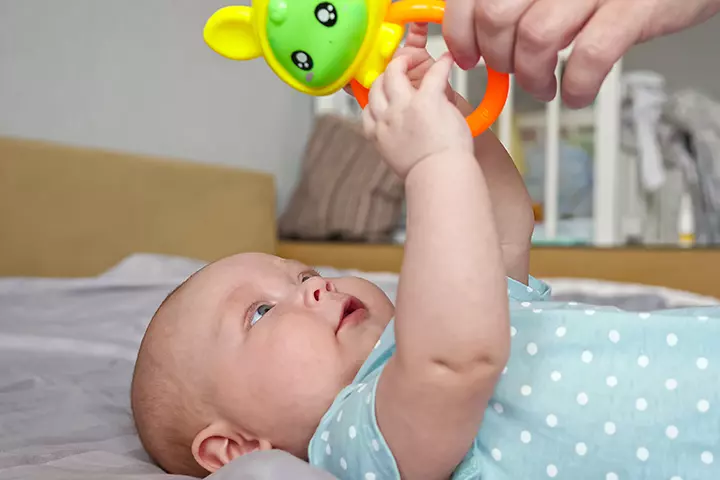
Gross motor skills, and physical growth and capabilities fall under this category.
- Keeps head steady: The little one has better control of his neck muscles, which make him hold his head steady when in your arms or during a feeding session (3).
- Sitting up: While they may not be able to sit unassisted for a while yet, you can support them in a seated position to help strengthen their back and neck muscles.
- Lifts head by 45º when on tummy: Stronger neck muscles let the baby lift his head to 45º when he is on his tummy by the end of two months itself (4). This action improves his field of vision, making it easier for him to see toys and other objects during tummy time.
- Eyes can track objects around 180º: We have all played silly games with our babies. Hold a toy in front of the baby and slowly move it in circles. The baby visually tracks the object by moving his head around. If that is not enough, hold the toy and move it from left to right. The infant tracks the object in a semi-arc. These abilities indicate an improved object tracking skill and vision (5).
- Pushes legs down when held vertical: When held vertical with support, the baby will push his legs down as if trying to stand on his legs. The three-month-old will not bounce nor bear weight on his feet at this stage, but has developed physical prowess to stretch limbs when the feet touch the ground (13).
- Bears body weight on forearms during tummy time: When lying on his belly, the infant bears his body weight on the forearms and may even push to lift his body as is done in push-ups (13). This lays the foundation for crawling – the first mode of movement in an infant’s life.
- Grasps toys, opens and closes fist: Better grip and enhanced finger dexterity enable grasping of toys and rattling them. The infant also swipes his arm towards objects that dangle, such as toys hanging from his stroller (2). This age is also when the baby develops hand-eye coordination, which is an essential motor skill.
- Brings hand to the mouth: At three months, the baby can bring his hands to his mouth and begin to suck their thumbs or fingers around this time because it’s the age when they really “discover” their hands, which become less stiff and more relaxed than earlier (6).
 Point to consider
Point to consider- Kicks and stretches legs when lying on back: When on his back, the baby stretches his legs and moves them around in a kicking action (2). It is the little one’s way of exploring movement and helps exercise the leg muscles.
- Rolling over and babbling: You’ll notice them making a variety of sounds, as they start to experiment with their vocal cords. Also, while some babies may take longer than others to master roll over, it’s important to give them plenty of supervised tummy time to encourage this development (13).
- Sleeps an hour less: A newborn sleeps around 16 hours a day for the first two months of his life. Your baby does not follow any sleep patterns or schedules in the first three months. By the time he is three months old, he sleeps for 15 hours, and mostly at night (7).
Because of the absence of sleep patterns, it is tough for your baby to get uninterrupted sleep at this age. As Florida mom Erin Payne says about her daughter, “Only recently has she been sleeping really, really well at night. She is 12 weeks old, and her naps are a whole other story. She is not really consistent with her naps (i).”
Social And Emotional Developmental Milestones
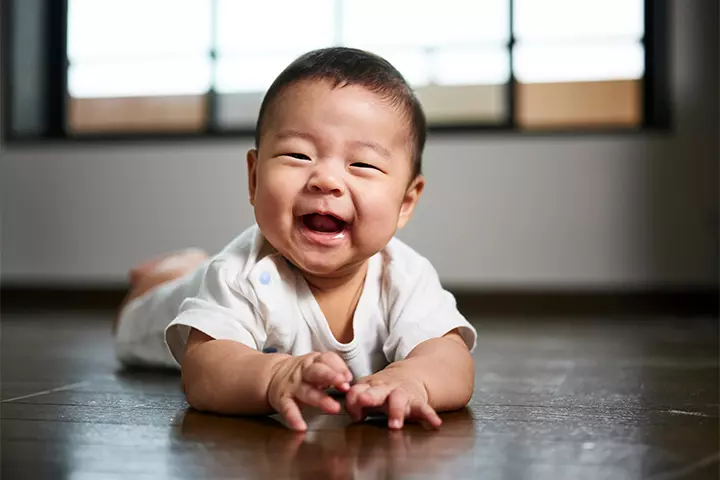
A baby will also develop his social skills and will mature in his emotional temperament by attaining social and emotional developmental milestones.
- Smiles at known individuals: Your baby may start smiling at the sound of your voice as early as six weeks. That adorable smile of the baby is his way of saying “Hello, how are you?” to the people he knows. The baby’s smile has a social purpose as it helps elicit a response (8). The smile could also be accompanied by body movements such as wide, open arms and violent movement of legs in excitement.
- Starts laughing: This age is when you will hear your little one laugh out loud! Babies will laugh for the first time around the age of three to four months (13).
- Enjoys playing with primary caretakers: No surprise here! The thing the baby loves the most at this age is to play with his parents and caretakers at home. Playing can be with toys or through simple hand movements.
- Can be reserved around strangers: While he welcomes friends and family with a broad smile, do not expect the same warmth towards strangers (13). A baby may give a fleeting smile or may not smile at all when he meets a stranger.
- Develops interest in siblings and other infants: Around this time your baby recognizes the existence of a sibling. If a brother or sister speaks to the three-month-old, the little one will smile and coo in response. The baby will also develop an interest towards other infants (14).
When To Be Concerned?
You must be watchful for the following warning signs of developmental delay in a three-month-old (2):
- Does not smile and respond to familiar faces: If the baby is expressionless even when greeted by a parent and stares blankly without any hint of recognition, then it may be a developmental delay.
- Does not make any sound: If you haven’t heard the baby cooing, chortling, or chuckling, then it is a serious sign of developmental delay, and the baby should be checked by a doctor soon.
- Head bobs backward or forward: By three months, babies have a decent head control. If the infant is unable to support his head during tummy time or when you lift him, then it could be a developmental delay.
- Unable to hold an object: This developmental delay is when the baby cannot grip an object, has abnormally loose grip, and makes no attempt at holding anything put in the baby’s hand.
- Inability to visually track objects or respond to sounds: By three months, the baby can track objects moving in circular or semicircular paths. He will also respond to the sounds and voices around him. An inability to do so is indicative of a delay in development.
- Does not pay attention to new faces, or seems very frightened by new faces or surroundings.
It is recommended to use development tracking to rule out any problems. As a parent, you can facilitate the healthy growth of your baby through some simple steps.
 Point to consider
Point to considerTips To Improve A Three-Month-Old’s Development
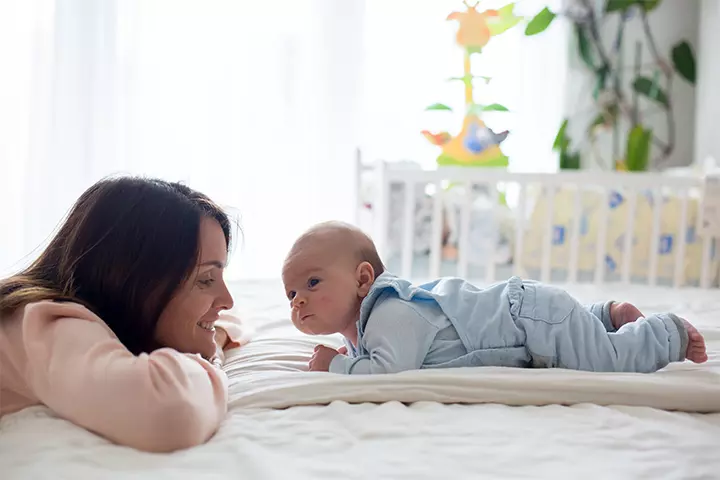
Here are some easy ways to ensure your little one is growing well (12):
- Have lots of tummy time: Tummy time strengthens several parts of the body – from arms to abdomen muscles. Stronger muscles help the baby stay on track with the milestones such as crawling. Play games that make the baby look around, as it helps the neck muscles get stronger.
- Interact with your baby: Have regular interactions and conversations with your baby. It will nurture his listening ability and responses, and also develop his social skills.
- Use words to describe actions: Incorporate words to describe activities. For instance, if you are reading a picture book, then say words such as “read” or “book”. The baby may not understand them, but when you repeat them next time, he may anticipate the corresponding action. Regular use of words can help maintain a daily routine with the baby.
- Play activities that let the baby track: Use a toy car tied to a string to grab the baby’s attention. Place a toy train and let the baby see it go round on the tracks. This would promote object tracking, which is an essential skill to master. You can also explore other learning activities for 3-month-old babies to enhance their cognitive development.
- Use sounds to get the baby’s attention: The other important sense at this age is the listening ability. At the age of three months, an infant will turn towards the source of sound. It is a good way to incorporate sound-based games where you use a rattle or the parent’s voice to draw the infant’s attention.
Some other ways you can help your baby’s development include (14):
- Call them by their name
- Give them rattling and soft toys
- Hang colorful and bright objects and danglers from the stroller
- Cuddle your baby
- Sing and play different music and sounds to your baby
- Read and show them big picture books
Make sure not to overstimulate your baby with several new experiences at once (13). Spend time with them to build a strong bond and make them feel secured. The CDC also recommends holding them and tending to their needs; caring for them at this age will not spoil them (15).
Regular pediatric check-ups are essential for monitoring your baby’s growth and development. Discuss any concerns you may have with your healthcare provider during these visits.
Frequently Asked Questions
1. How long should a tummy time be at three months?
Experts suggest that you may give about one hour of tummy time daily to your three-month-old. However, ensure to facilitate tummy time on a low, safe surface and supervise your baby all the time (9).
2. Can a three-month-old watch TV?
No, it is not advisable to let your three-month-old watch TV. The American Academy of Pediatrics suggests avoiding TV or screen exposure time for children before 18 months (10).
3. How do I stimulate my three-month-old baby’s development and emotional security?
Most babies begin recognizing and responding to familiar faces by three months. Be patient and responsive to your baby’s needs at this crucial time. To help them develop their emotional abilities, you may talk, sing, smile often, and engage in tummy time activities (11). You may also take tips on 3 months baby care from other parents and experts.
If you track your three-month-old baby’s development, you will realize that they have grown in every category, whether it is physical, social, or emotional. Most children will recognize familiar faces, imitate sounds, and copy some actions. They will also keep their head steady, grasp toys, smile at known people, and laugh aloud. Although every child is different and attains milestones at different times, you should be vigilant about warning signs. If your child does not respond or smile, keep their head steady, or hold an object, consult a doctor. Meanwhile, you can also enhance their development by having tummy time, interacting with your baby, or playing. Proper care and support will ensure your baby grows healthy.
Infographic: A Day In The Life With A Three-Month-Old
As your baby is three months, you may feel like you have begun to hit your stride as a parent and have adapted to living with your little family member. You will find your baby growing and changing almost daily and looking different from how they were as newborns. Have a look at the following infographic to understand the milestones you can expect in the life of a three-month-old. Illustration: Momjunction Design Team
Illustration: 3-Month-Old Baby&039s Developmental Milestones & Tips To Support
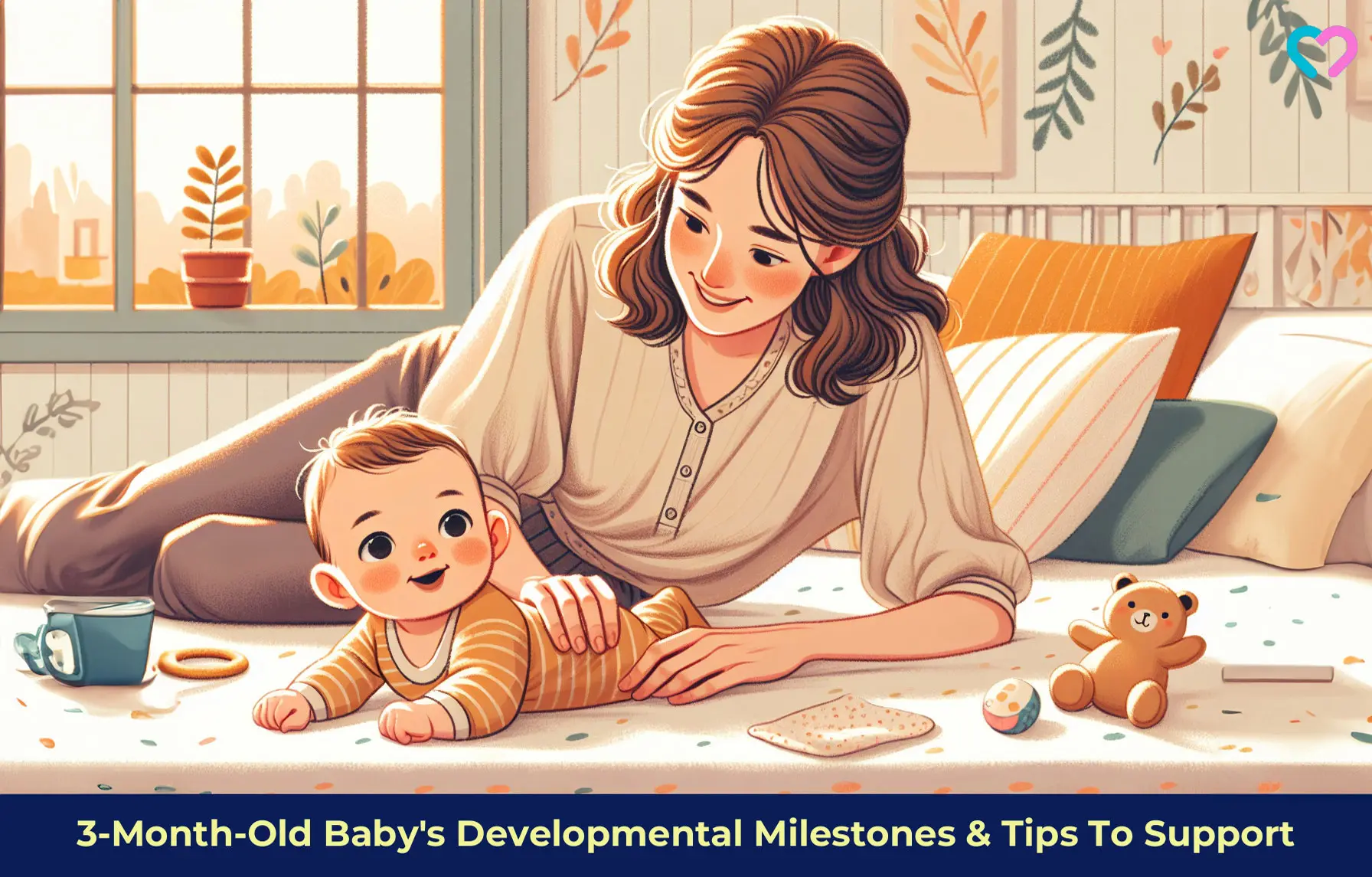
Image: Dall·E/MomJunction Design Team
Exciting new developments! Learn about the motor milestones to look for in your 0-3 month old baby.
Personal Experience: Source
MomJunction articles include first-hand experiences to provide you with better insights through real-life narratives. Here are the sources of personal accounts referenced in this article.
i. Daily Baby Routine (3 Month Old) Full 24 Hours With an Infant — Nap Training & Sleep Schedule. https://www.youtube.com/watch?v=utoSk6OgiWIReferences
- First Year Infant Development.
https://americanpregnancy.org/healthy-pregnancy/first-year-of-life/first-year-infant-development/ - Developmental Milestones: 3 Months.
https://www.healthychildren.org/English/ages-stages/baby/Pages/Developmental-Milestones-3-Months.aspx - Child development (1) – newborn to three months.
https://www.betterhealth.vic.gov.au/health/healthyliving/child-development-1-newborn-to-three-months - Developmental milestones record – 2 months.
https://medlineplus.gov/ency/article/002006.htm - Infant Vision: Birth to 24 Months of Age.
https://www.aoa.org/healthy-eyes/eye-health-for-life/infant-vision?sso=y - Developmental Milestones: Fine Motor Skills and Visual Motor Skills.
https://www.choc.org/userfiles/file/Rehab-Developmental%20Milestones%20final.pdf - Infant Sleep.
https://www.stanfordchildrens.org/en/topic/default?id=infant-sleep-90-P02237 - Emotional & Social Development in Babies: Birth to 3 Months.
https://www.healthychildren.org/English/ages-stages/baby/Pages/Emotional-and-Social-Development-Birth-to-3-Months.aspx - Tummy Time.
https://kidshealth.org/en/parents/tummy-time.html#:~:text=As%20your%20baby%20gets%20used%20to%20it%2C%20place%20your%20littlelook%20up%20and%20push%20up - Why to Avoid TV for Infants & Toddlers.
https://www.healthychildren.org/English/family-life/Media/Pages/Why-to-Avoid-TV-Before-Age-2.aspx - 3-4 months: baby development.
https://raisingchildren.net.au/babies/development/development-tracker-3-12-months/3-4-months - Infant development: Birth to 3 months.
https://www.mhsystem.org/health-library/art-20048012 - Your baby’s growth and development – 3 months old.
https://www.pregnancybirthbaby.org.au/babys-growth-and-development-3-months-old - 1-3 Months Old Baby Development.
https://choc.org/primary-care/ages-stages/1-to-3-months/ - Important Milestones: Your Baby By Two Months
https://www.cdc.gov/ncbddd/actearly/milestones/milestones-2mo.html
Community Experiences
Join the conversation and become a part of our nurturing community! Share your stories, experiences, and insights to connect with fellow parents.
Read full bio of Dr. Ashraf Kasem
Read full bio of Rohit Garoo
Read full bio of Dr. Ritika Shah
Read full bio of Vibha Navarathna









